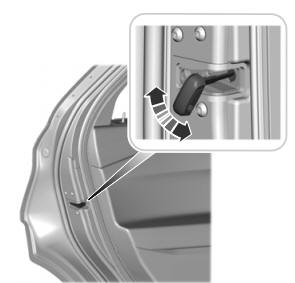Ford Explorer: Anti-Lock Brake System (ABS) and Stability Control / Description and Operation - Anti-Lock Brake System (ABS) and Stability Control - Overview
Overview
The ABS and stability control systems are comprised of the following subsystems to assist the driver in maintaining control of the vehicle:
- ABS
- Curve control
- Drive away release (EPB)
- EBD
- EPB control
- ESC
- Hill descent control
- Hill start assist
- Hydraulic fade compensation
- RSC
- Selectable drive modes
- Supplemental braking assist
- Supports adaptive cruise control
- Supports collision avoidance
- Traction control
- Trailer sway control
The ABS helps maintain steering control during hard braking by preventing wheel lock up. The ABS also includes a brake assist function which provides maximum brake system pressure during a severe braking situation.
The curve control system helps maintain vehicle stability while traveling through a curve.
The drive away release function automatically releases the electric parking brake once certain conditions have been met.
The EBD system helps maintain vehicle control by keeping a balanced braking condition between the front and rear wheels.
The ABS module is the ECU for the electric parking brake system. For information on the electric parking brake system,
Refer to: Parking Brake - System Operation and Component Description (206-05 Parking Brake and Actuation, Description and Operation).
The ESC system helps prevent skids or lateral slides by modulating brake fluid pressure to individual brake calipers and reducing engine torque.
The hill descent control feature helps to maintain a low vehicle speed while descending steep inclines on various surface conditions.
The hill start assist feature is designed to assist the driver when trying to start the vehicle while on an incline. Using the ABS, the hill start assist system holds the vehicle on an incline for a short time, allowing the driver to release the brake pedal and press the accelerator pedal without needing to use the parking brake.
Hydraulic fade compensation counteracts brake fade by providing additional brake pressure at the wheel ends if the maximum achievable vehicle deceleration is not reached when the driver applies significant force to the brake pedal.
The RSC system helps prevent excessive vehicle roll by modulating brake fluid pressure to individual brake calipers and reducing engine torque.
The supplemental braking assist system uses the hydraulic pump motor and HCU to provide additional braking assist during a severe braking event or to or to assist with adaptive cruise control and collision avoidance.
The ABS
supports the adaptive cruise control system by applying the brakes as
necessary to maintain the distance gap set by the driver. For
information on the adaptive cruise control system,
Refer to: Cruise Control - System Operation and Component Description (419-03B Cruise Control - Vehicles With: Adaptive Cruise Control With Lane Centering, Description and Operation).
The ABS
supports the collision avoidance system by monitoring information and
precharging the brake system allowing the vehicle to stop in the
shortest distance possible. For information on the collision avoidance
system,
Refer to: Collision Warning and Collision Avoidance System - System Operation and Component Description (419-03C Collision Warning and Collision Avoidance System, Description and Operation).
The selectable drive mode system helps maintain vehicle traction by adapting the responses of the engine, transmission, 4WD system, the dynamic suspension system, the EPAS system, the ABS and the stability control system to the demands of the terrain. For additional information on the selectable drive mode system,
The traction control system helps prevent loss of traction by reducing drive-wheel spin during acceleration.
The trailer sway control system helps maintain vehicle stability while towing a trailer by detecting and helping to reduce the conditions causing trailer sway
Some noise from the system and pulsations in the brake pedal are normal conditions during most ABS and stability control system activations. Longer than normal brake pedal travel may also be experienced immediately following an ABS or stability control system activation.
 Description and Operation - Anti-Lock Brake System (ABS) and Stability Control - System Operation and Component Description
Description and Operation - Anti-Lock Brake System (ABS) and Stability Control - System Operation and Component Description
System Operation
System Diagram
Item
Description
1
ABS module
2
Hydraulic pressure sensor
3
EBB assembly
4
Wheel speed sensors
5
GWM
6..
Other information:
Ford Explorer 2020-2025 Service Manual: Removal and Installation - Rear Window Wiper Pivot Arm
Special Tool(s) / General Equipment Two Leg Puller Removal Open the wiper pivot arm nut cover. Remove the wiper pivot arm nut. Remove the wiper pivot arm. Use the General Equipment: Two Leg Puller Installation Verify the windshield wiper motor is in the PARK position...
Ford Explorer 2020-2025 Service Manual: Removal and Installation - Air Inlet Door Actuator
Removal Remove the climate control housing. Refer to: Climate Control Housing (412-00 Climate Control System - General Information, Removal and Installation). Remove the screws and the air inlet door actuator. Disconnect the electrical connector...
Categories
- Manuals Home
- 6th Generation Explorer Owners Manual
- 6th Generation Explorer Service Manual
- Description and Operation - Identification Codes
- Electric Parking Brake
- Traction Control
- New on site
- Most important about car
Child Safety Locks
When these locks are set, you cannot open the rear doors from the inside.

A child safety lock is on the rear edge of each rear door. You must set the child safety lock separately on each door.
Left-Hand Side

